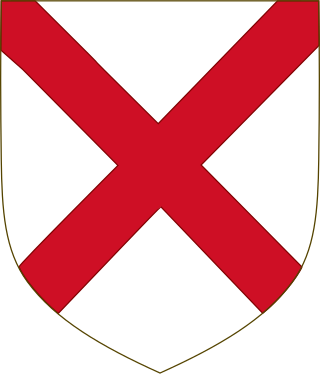
The FitzGerald dynasty is a noble and aristocratic dynasty of Cambro-Norman and Anglo-Norman origin. They have been peers of Ireland since at least the 13th century, and are described in the Annals of the Four Masters as having become "more Irish than the Irish themselves" or Gaels, due to assimilation with the native Gaelic aristocratic and popular culture. The dynasty has also been referred to as the Geraldines and Ireland's largest landowners. They achieved power through the conquest of large swathes of Irish territory by the sons and grandsons of Gerald de Windsor. Gerald de Windsor was the first Castellan of Pembroke Castle in Wales, and became the male progenitor of the FitzMaurice and FitzGerald Dynasty. His father, Baron Walter FitzOther, was the first Constable and Governor of Windsor Castle for William the Conqueror, and was the Lord of 38 manors in England, making the FitzGeralds one of the "service families" on whom the King relied for his survival.
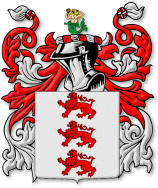
The name McInerney is of noble Irish origin where it is found in the modern Irish form of Mac an Airchinnigh and in the old and literary forms of Mac an Oirchinnigh and Mac an Oirchindig. The pronunciation of Mac an Oirchinnigh led the name to be sometimes anglicised as McEnherheny in Irish documents from the 16th–19th centuries. The name translates to "son of the erenagh" in Irish, literally meaning "son of the Lord of church lands". Airchinneach may in turn derive from the twin components of air ("noble") and ceann ("head"), therefore meaning a 'noble-head' or 'Lord', denoting its aristocratic status in medieval Ireland. The coat of arms is three red lions passant, and the motto is Veritas, meaning "Truth". In some places, the motto can be found as Vincit Veritas, meaning "Truth Conquers", or "Truth Prevails".

Maurice FitzThomas FitzGerald, 1st Earl of Desmond in Dublin Castle, Dublin, Ireland was an Irish nobleman in the Peerage of Ireland, Captain of Desmond Castle in Kinsale, so-called ruler of Munster, and for a short time Lord Justice of Ireland. Called "Maurice the Great", he led a rebellion against the Crown, but he was ultimately restored to favour.
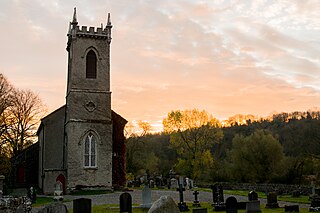
Saint Peter's Church, Ennisnag is a church of the United Dioceses of Cashel and Ossory and the ecclesiastical province of the United Provinces of Dublin and Cashel in the (Anglican) Church of Ireland. The church lies beside the Kings River, one mile north of Stoneyford village in County Kilkenny, Ireland. Located in the townland of Ennisnag, in the barony of Shillelogher.

Knocktopher is a village in County Kilkenny, Ireland. It is situated on the R713 road between the villages of Stoneyford to the north, and Ballyhale to the south. It was formerly situated on the N10 national route until being bypassed by the M9 motorway. It is also a civil parish in the eponymous barony of Knocktopher.
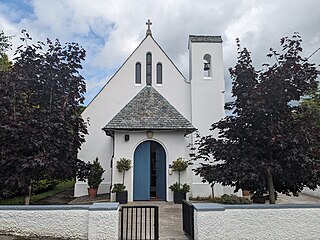
Kilteel is the name of a village, townland and civil parish located in the barony of South Salt, County Kildare, Ireland. The townland of Kilteel Upper contains the remains of a church with a decorated Romanesque chancel arch, the ruins of a 13th-century preceptory of the Knights Hospitaller and a well-preserved 15th-century tower house. The historic settlement is located on the southwest corner of the English Pale and served an important function as a border fortress during the medieval period.

Ida is a barony in the south-east of County Kilkenny, Ireland. Ida is made up of 16 civil parishes containing 191 townlands, it is one of 12 baronies in the County. The barony is 249.8 square kilometres (96.4 sq mi) in size, with highest point at Tory Hill. The chief town is Slieveroe. The N25 crosses the barony.
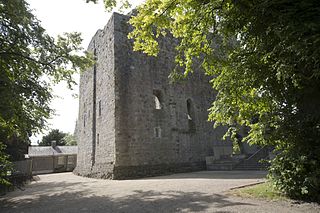
Thomas FitzJohn FitzGerald, 7th Earl of Kildare, was an Irish peer and statesman of the fifteenth century who held the office of Lord Chancellor of Ireland.
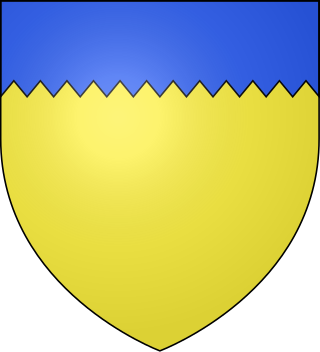
Butler is the name of a noble family whose members were, for several centuries, prominent in the administration of the Lordship of Ireland and the Kingdom of Ireland. They rose to their highest prominence as Dukes of Ormonde. The family has produced multiple titles such as Baron Cahir, Baron Dunboyne, Viscount Ikerrin, Viscount Galmoye, Viscount Mountgarret, Viscount Thurles, Earl of Carrick, Earl of Kilkenny, Earl of Ormond, Earl of Ossory, Marquess of Ormonde and Duke of Ormonde. Variant spellings of the name include le Boteler and le Botiller. The Butlers were descendants of Anglo-Norman lords who participated in the Norman invasion of Ireland in the 12th century. The surname has its origins in the hereditary office of "Butler (cup-bearer) of Ireland", originating with Theobald Walter, 1st Chief Butler of Ireland. The arms of later family members depicted three cups in recognition of their original office.
Thomas FitzGerald of Turlough (1661-1747) was an Irish landowner.
Philip de Barry, was a Cambro-Norman warrior from Manorbier in Pembrokeshire who participated in the colonisation of Kingdom of Desmond following the Norman invasion of Ireland. He was the founder of the Barry or De Barry family in County Cork, and common ancestor of the barons Barry and earls of Barrymore.
Imokilly is one of the baronies of Ireland, an historical geographical unit of land. Its chief town is Youghal. It is one of 24 baronies in the county of Cork. Other neighbouring baronies include Barrymore to the west and Kinnatalloon to the north.

Freynestown is a townland in the civil parish of Tiscoffin in the barony of Gowran, County Kilkenny, Ireland. Freynestown was anciently located in the Kingdom of Ossory and derives its name from the Cambro-Norman family of "de la Freyne.".
Rathmore, a village, civil parish and District electoral division in County Kildare, Ireland, is located at the western edge of the Wicklow Mountains in the barony of Naas North. The original settlement was at the southwest corner of the English Pale, serving an important function as a border fortress during the medieval period.
Kilcurl comprises the two townland areas of Kilcurl Anglesey and Kilcurl Feronsby. The townlands are situated one mile (1.6 km) from its nearest village, Knocktopher, and located on a road to Carrickshock monument one mile (1.6 km) away and two miles (3.2 km) to Ballyhale. The village of Knocktopher is situated in the parish of Ballyhale, south County Kilkenny, in Ireland.

Camagh is a townland in the civil parish of Templeport, County Cavan, Ireland. It lies in the Roman Catholic parish of Templeport and barony of Tullyhaw. The local pronunciation is Commagh.

Gowran is a barony in the east of County Kilkenny, Ireland. The size of the barony is 430.5 square kilometres (166.2 sq mi). There are 35 civil parishes in Gowran. The chief town today is Gowran. The barony contains the ecclesiastical sites of Kilfane and Duiske Abbey The barony of Gowran is situated in the east of the county between the baronies of Fassadinin to the north, the baronies of Kilkenny, Shillelogher and Knocktopher to the west, and the barony of Ida is to the south. It borders County Carlow to the east. The M9 motorway bisects the barony.

The barony of Knocktopher is a barony in the west of County Kilkenny, Ireland. The barony is 46,765 acres (189.25 km2) in size. There are 16 civil parishes made up of 125 townlands. It is one of 12 baronies in the county. The chief town is Mullinavat and it contains the settlements of Stonyford, Ballyhale, Hugginstown, Knocktopher, and Dunnamaggan. The M9 motorway bisects the barony.

Fassadinin, sometimes written Fassadining, is a barony in the north of County Kilkenny, Ireland. It is one of 12 baronies in County Kilkenny. The size of the barony is 276.2 square kilometres (106.6 sq mi). There are 19 civil parishes in Fassadinin. The chief town today is Castlecomer. The N78 Kilkenny/Athy road bisects the barony. Fassadinin is currently administered by Kilkenny County Council.

Castle Carra is a hall house and National Monument located in County Mayo, Ireland.














